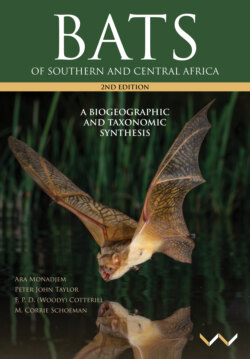Читать книгу Bats of Southern and Central Africa - Ara Monadjem - Страница 15
На сайте Литреса книга снята с продажи.
THE VALUE OF SPECIMENS
ОглавлениеMany of the known bat records – vouched for by preserved specimens of bats – have been published. For example, the first article devoted exclusively to the bats of Zimbabwe (Harrison 1959) summarised new material added to the museum collections of the country. In the main, these older articles were published in museum journals that are relatively hard to obtain, or the data reside in monographs long out of print (e.g. Ansell 1978, Smithers and Wilson 1979). Existing taxonomic uncertainties often undermine the credibility of these historical data, but fortunately, nearly all the originally reported specimens still exist – in museum collections. Continued preservation of each specimen maintains a node of original data, whose persistence over time acts to anchor the interconnecting web of knowledge. By remaining available for independent re-examinations, each of these specimens maintains the veracity of scientific knowledge. An excellent example is the recent revision of Afrotropical slit-faced bats, Nycteris, using specimens (Demos et al. 2019a). The value of natural history collections preserved in museums increases with time, but they are regrettably too often neglected, even within the biological community (Cotterill 1995a, 1999, 2002c, 2016, Cotterill and Foissner 2010, Gippoliti 2018).
The loss of any one of these specimens, let alone an entire collection, has severe consequences. A pertinent example is the fire that destroyed a wealth of unique zoological specimens at the Museu Bocage, Lisbon, in March 1978. Its depredations on scientific knowledge included the destruction of all the type material of the Chiroptera described by J. V. Barboza du Bocage and A. F. de Seabra from Angola (see Palmeirim et al. 1979, Bergmans 1990). In this book we repeatedly refer to the problems these losses will continue to cause in bat taxonomy for many taxa.
These specimens are the fundamental sources of scientific data to support efforts to conserve biodiversity, as explicitly recognised by the 1992 Convention on Biological Diversity. The distribution maps in this book are based entirely on museum specimens representing 6,344 unique locality-species records (Figure 11), 73% of which have been personally checked by at least one of the co-authors (marked as red dots on the map in Figure 11). These collections provide unique references for the scientific identification of new specimens, as they include those type specimens that vouch for the formal description of species (Cotterill 1995a, b, 1999, 2002c, Cotterill and Dangerfield 1997, Cotterill and Foissner 2010, Gippoliti 2018, Taylor et al. 2019a).
Figure 5. (a) The study skins and skull collection of small mammals in Bulawayo is estimated at over 50,000 specimens, including invaluable series of bats. A series of Mops midas is arrayed in the foreground. (b) A small part of the wet collection of mammals, Natural History Museum of Zimbabwe, Bulawayo (© F. P. D. Cotterill).
Discovery of new species of bats continues today in many biodiversity hotspots, including parts of Africa (e.g. Taylor et al. 2012, 2018a, 2019a, Monadjem et al. 2013a, b, Kerbis Peterhans et al. 2013, Decher et al. 2015). This is in part due to new collections from remote areas, as well as sophisticated new taxonomic tools, which include echolocation studies and systematic revisions that incorporate molecular evidence (DNA sequences). As with any serious biogeographical or taxonomic work, the direct study of specimens is essential to the scientific credibility of all such research.
